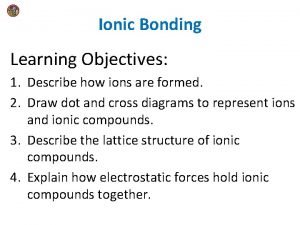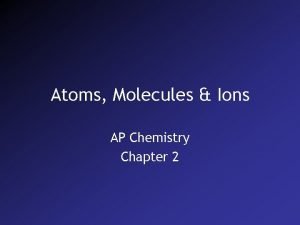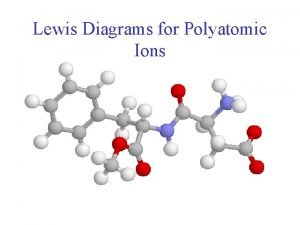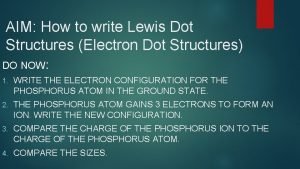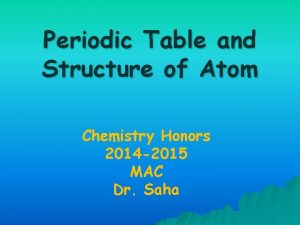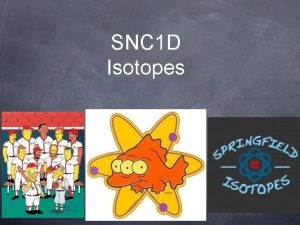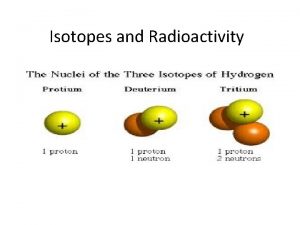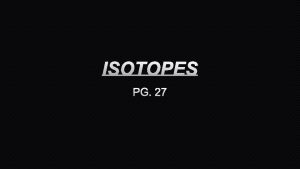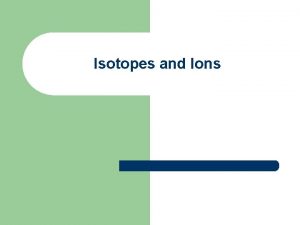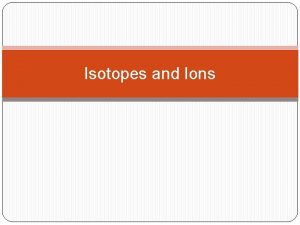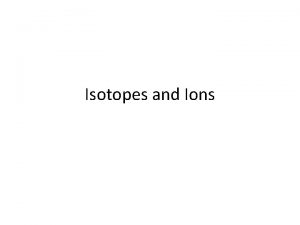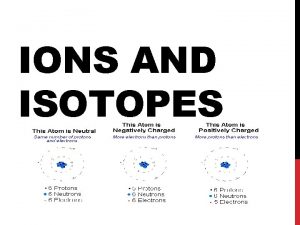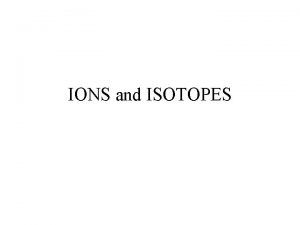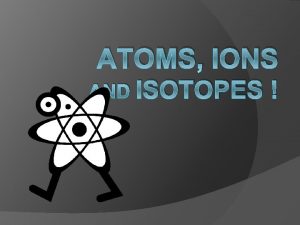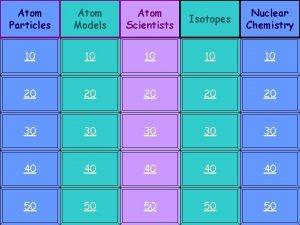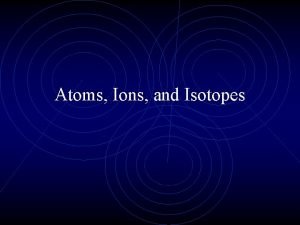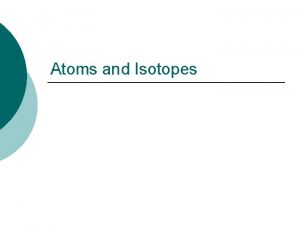Atoms Isotopes Ions The Structure of the Atom






















- Slides: 22

Atoms, Isotopes, & Ions

The Structure of the Atom An atom consists of a • nucleus – protons and neutrons • electrons in orbitals around the nucleus. Electron cloud Nucleus

Atomic Number vs Mass Number • Atomic # = # of protons in an atom Mass Number 4 Atomic Number 2 • Mass # = # of protons + neutrons in an atom He

Isotopes • Isotopes - Atoms of the same element but different mass number. • Boron-10 (10 B) has 5 p and 5 n • Boron-11 (11 B) has 5 p and 6 n 11 B 10 B

Isotopes? Which of the following represent isotopes of the same element? Which element? 234 92 X 234 X 93 235 92 X 238 92 X

Isotopes & Their Uses Bone scans with radioactive technetium-99.

Isotopes & Their Uses The tritium content of ground water is used to discover the source of the water, for example, in municipal water or the source of the steam from a volcano.

Counting Protons, Neutrons, and Electrons • Protons: Atomic Number (from periodic table) • Neutrons: Mass Number minus the number of protons (mass number = protons +neutrons) • Electrons: – If it’s an atom, the protons and electrons must be the SAME so that it is has a net charge of zero (equal numbers of + and - charges) – If it does NOT have an equal number of protons & electrons, it is NOT an atom, it is an ION.

Learning Check Naturally occurring carbon consists of three isotopes, 12 C, 13 C, and 14 C. State the number of protons, neutrons, and electrons in each of these carbon atoms. 12 C 13 C 6 14 C 6 #p+ _______ #no _______ #e- _______ 6

Answers 12 C 13 C 6 6 14 C 6 #p+ 6 6 6 #no 6 7 8 #e- 6 6 6

IONS • IONS are atoms or groups of atoms with a positive or negative charge. • Taking away an electron from an atom gives it a positive charge. • Adding an electron to an atom gives it a negative charge. • To tell the difference between an atom and an ion, look to see if there is a charge in the superscript! Examples: Na+ Ca+2 I- O-2 Na Ca I O

Forming Cations & Anions A CATION forms when an atom loses one or more electrons and therefore has an overall positive charge. An ANION forms when an atom gains one or more electrons and therefore has an overall negative charge.

QUESTIONS • What is the result when the number of electrons for a given atom changes? • What is the result when the number of neutrons for a given atom changes? • What is the result when the number of protons for a given atom changes?

Learning Check An atom has 14 protons and 20 neutrons. A. Its atomic number is 1) 14 2) 20 3) 34 B. Its mass number is 1) 14 2) 20 3) 34 C. The element is 1) Si 2) Ca 3) Se D. Another isotope of this element is 1) 34 X 2) 34 X 3) 36 X 16 14 14

Visualizing Isotopes & Ions • Hydrogen Ion: http: //web. visionlearning. com/custom/chemis try/animations/CHE 1. 3 -an-ions. shtml • Hydrogen Isotope: http: //web. visionlearning. com/custom/chemis try/animations/CHE 1. 3 -an-isotopes. shtml

Learning Check State the number of protons, neutrons, and electrons in each of these ions. 39 K+ 16 O -2 19 41 Ca +2 8 #p+ _______ #no _______ #e- _______ 20

One Last Learning Check Write the nuclear symbol form for the following atoms or ions: A. 8 p+, 8 n, 8 e- ______ B. 17 p+, 20 n, 17 e- ______ C. 47 p+, 60 n, 46 e- ______

Isotopes and Average Atomic Mass - A sample of any element consists of one or more isotopes of that element. - Each isotope is a different weight. - The relative amounts of each isotope for any element represents the isotope distribution for that element. - The atomic weight is the average of the isotope weights weighted for the isotope distribution Atomic Mass =[(mass of isotope) (%abundance) ] + [(mass of isotope) (%abundance)] + […. ] 100%

Practice Problem • The natural abundance for boron isotopes is: 19. 9% 10 B (10. 013 amu) and 80. 1% 11 B (11. 009 amu). Calculate the atomic weight of boron.

Some Humor A neutron walks into a restaurant and orders a couple of drinks. As she is about to leave, she asks the waiter how much she owes. The waiter replies, “For you, No Charge!!!”


Next week…how does atomic structure relate to the periodic table?
 Isotopes pogil
Isotopes pogil What do the roman numerals in a cation's name indicate?
What do the roman numerals in a cation's name indicate? Positive ions are atoms that have
Positive ions are atoms that have Ion chapter 11
Ion chapter 11 Atoms molecules and ions
Atoms molecules and ions Atoms molecules and ions
Atoms molecules and ions Atoms or ions are considered isoelectronic if
Atoms or ions are considered isoelectronic if Atoms molecules and ions
Atoms molecules and ions Atoms ions and molecules
Atoms ions and molecules Atoms ions and molecules
Atoms ions and molecules Collision theory states that
Collision theory states that Chapter 2 atoms molecules and ions
Chapter 2 atoms molecules and ions The structure of the atom section 2 defining the atom
The structure of the atom section 2 defining the atom Periodic table of elements regents
Periodic table of elements regents Section 2 quantum theory and the atom
Section 2 quantum theory and the atom Electrons in atoms section 2 quantum theory and the atom
Electrons in atoms section 2 quantum theory and the atom Perkembangan teori atom democritus
Perkembangan teori atom democritus Lewis structure of hcoo-
Lewis structure of hcoo- How to draw a lewis dot diagram for an element
How to draw a lewis dot diagram for an element What is this called
What is this called Fertile isotopes
Fertile isotopes Calculating the average atomic mass
Calculating the average atomic mass How do you calculate atomic mass
How do you calculate atomic mass


